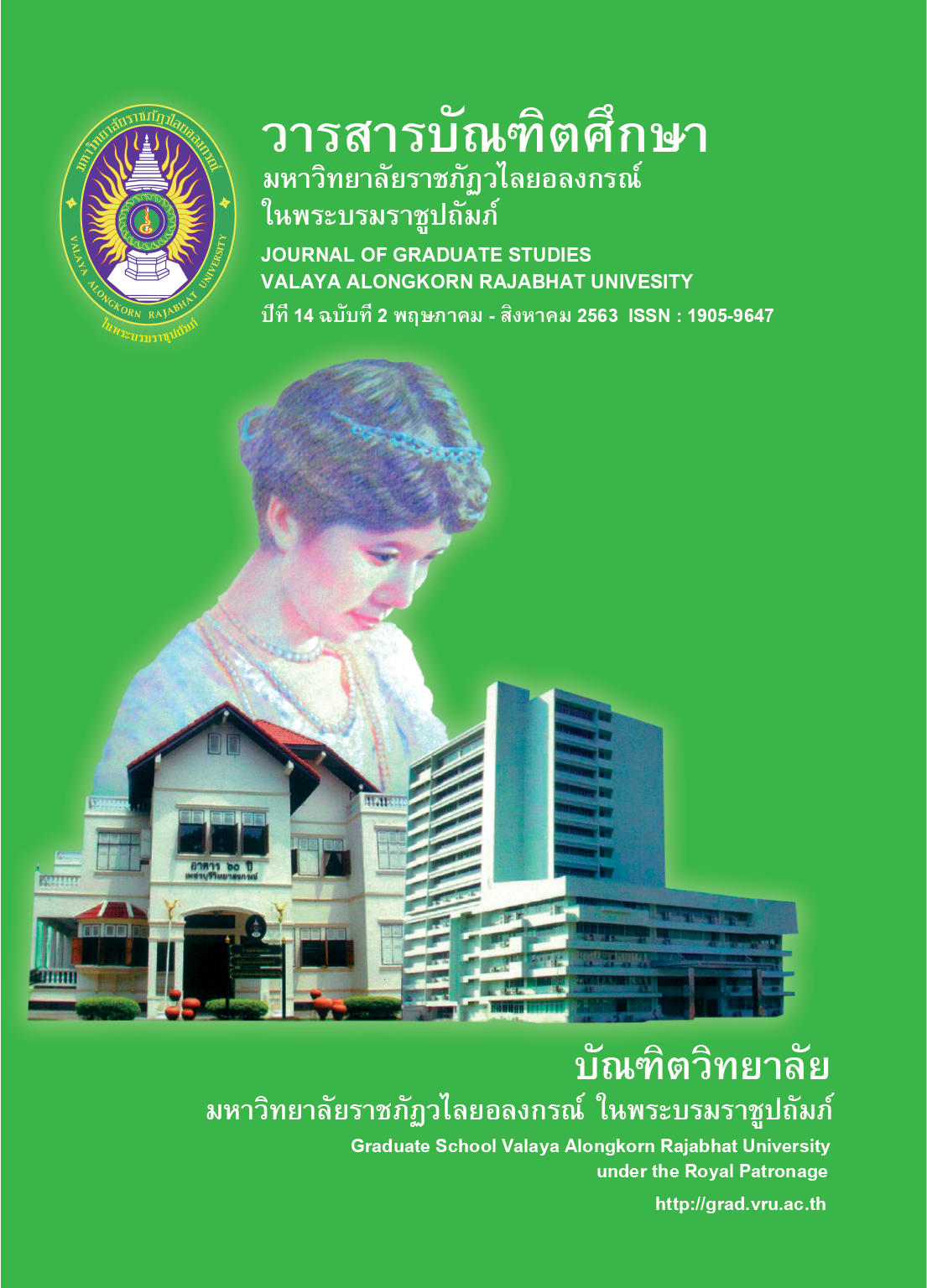DEVELOPMENT OF FACTORS AND BEHAVIORS INDICATING HISTORICAL THINKING OF SECONDARY SCHOOL STUDENTS
Main Article Content
Abstract
This research aims was to developing factors and behaviors indicating historical thinking. The research methodology comprises three steps. Step 1, systematic data extraction was used to analyze historical concepts from 12 data sources in order to make a synthesis of behaviors indicating historical thinking of each factor. Step 2, an assessment of factors and behaviors of historical thinking were assessed and corrected by means of semi-structured interview by 5 experts. Step 3, 5 experts in social studies were invited to reach consensus and suggest forms of focus group discussion. The research found that there are 5 historical thinking factors, namely, 1) Historical sources and evidence consisting of 9 indicating behaviors, 2) Chronological reasoning consisting of 14 indicating behaviors, 3) Making historical connection consisting of 7 indicating behaviors, 4) Historical significance consisting of 2 indicating behaviors, 5) Historical empathy and ethical dimension consisting of 8 indicating behaviors.
Article Details

This work is licensed under a Creative Commons Attribution-NonCommercial-NoDerivatives 4.0 International License.
บทความทุกเรื่องได้รับการตรวจความถูกต้องทางวิชาการโดยผู้ทรงคุณวุฒิ ทรรศนะและข้อคิดเห็นในบทความ Journal of Global of Perspectives in Humanities and Social Sciences (J-GPHSS) มิใช่เป็นทรรศนะและความคิดของผู้จัดทำจึงมิใช่ความรับผิดชอบของบัณฑิตวิทยาลัย มหาวิทยาลัยราชภัฏวไลยอลงกรณ์ ในพระบรมราชูปถัมภ์ กองบรรณาธิการไม่สงวนสิทธิ์การคัดลอก แต่ให้อ้างอิงแหล่งที่มา
References
Andrews, T., & Burke, F. (2007). What does it mean to think historically?. Retrieved from https://www.historians.org/publications-and-directories/perspectives-on-history/january-2007/what-does-it-mean-to-think-historically.
Brown, D. (2004). A comparative analysis of historical thinking skills in the history standards of seven states: California, Idaho, Illinois, Indiana, Massachusetts, Texas, Virginia. Doctoral dissertation. Indiana University.
Brugar, K. A. (2012). What difference does curricular integration make? An inquiry of fifth graders’ learning of history through the use of literacy and visual arts skills. Michigan: Michigan State University.
Bureau of Academic Affairs and Educational Standards. (2009). tūa chī wat læ sāra kān rīanrū kǣn klāng klum sāra kān rīanrū sangkhommasưksā sātsanā læ watthanatham tām laksūt kǣn klāng kānsưksā naphư̄n thān Phutthasakkarāt sō̜ngphanhārō̜ihāsipʻet [Indicators and core content of Social studies, Religion and Culture Learning areas based on Basic Education Core Curriculum B.E. 2551 (A.D. 2008)]. Bangkok: The Agricultural Cooperative Federation of Thailand.
Burenheide, B. (2007). I can do this: Revelations on teaching with historical thinking. The History Teacher. 41(1), 55-61.
Champa, S. (2016). kānphatthanā rūpbǣp kānčhatkān rīanrū prawattisāt thō̜ngthin dōi chai lǣng rīanrū thāng prawattisāt phư̄a songsœ̄m krabūankān khit thāng prawattisāt [The development of instructional model of local history by historical learning sources for supporting historical thinking process]. Doctoral dissertation. Silpakorn University.
College Board. (2015). AP United States history: Course and exam description. New York: CollegeBoard.
Crochet, M. (2015). Exploring preservice teacher education that connects technology use and historical thinking in the social studies classroom: A case study. Fairfax, VA: George Mason University.
Drake, F. D., & Brown, S. D. (2003). A systematic approach to improve students’ historical thinking. The History Teacher. 36(4), 445-479.
Holt, T. (1990). Thinking historically: Narrative, imagination, and understanding. New York, NY: College Board.
Lee, P. (2005). Putting principles into practice: Understanding history. In Donovan & Bransford (Ed.), How Students Learn: History in the classroom (pp. 31-77). Washington D.C.: National Academic Press.
Lévesque, S. (2009). Thinking historically: Educating students for the twenty-first century. Toronto: University of Toronto Press.
Nation Council for the Social Studies. (2004). National standards for social studies teachers. Retrieved from http://downloads.ncss.org/NCSSTeacherStandsVol1-rev2004.pdf.
National Center for History in the Schools. (1996). National standards for history: basic edition. Retrieved from http://www.nchs.ucla.edu/history-standardsใ
Pana, S. (2017). kānphatthanā rūpbǣp kān rīan kānsō̜n prawattisāt tām nǣokhit krabūankān sư̄p sō̜p sawǣng hākhwām rū pen klum rūam kap nǣokhit Magic if phư̄a songsœ̄m thaksa kān khit thāng prawattisāt læ kānraprū khwāmrū sưk thāng prawattisāt khō̜ng nakrīan radap matthayommasưksā tō̜n plāI [Development of history instruction based on group investigation and magic if approaches to promote historical thinking skills and historical empathy of upper secondary school students]. Doctoral dissertation. Chulalongkorn University.
Pellecchia, S. (2015). Teaching with primary sources: the overlap between historical thinking and critical literacy. New York: Fordham University.
Reisman, A. (2012). The document-based lesson: Brining disciplinary inquiry into high school history classrooms with adolescent struggling readers. Journal of Curriculum Studies. 44, 233-264.
Seixas, P., & Morton, T. (2013). The big six: Historical thinking concepts. Toronto: Nelson Education.
Seixas. P. (1996). Conceptualizing the growth of historical understanding. In Olson & Torrance (Ed), Handbook of education and human development: New models of learning, teaching and schooling (pp. 765-783). Malden, MA: Blackwell.
Sullivan, C. (2007). Engaging with socioconstructivist pedagogy: Four social studies preservice teachers’ understandings and experiences in contemporary classrooms. Austin: University of Texas at Austin.
Tosila, C. (2012). kānphatthanā krabūankān rīan kānsō̜n dōi chai withīkān thāng prawattisāt phư̄a songsœ̄m thaksa kān khit thāng prawattisāt khō̜ng nakrīan matthayommasưksā pī thī sō̜ng [Development of instructional process by using historical method to enhance historical thinking skills of eighth grade students]. Doctoral dissertation Chulalongkorn University.
VanSledright, B. (2010). What does it mean to think historically and how do youteach it?. Retrieved from https://www.socialstudies.org/publications/ socialeducation/what-does-it-mean-to-think-historically-and-how-do-you-teach-it.
Wilson, S., & Wineburg, S. (1988). Peering at history through different lenses: Therole of disciplinary perspectives in teaching history. Teachers college record. (89), 525-539. Retrieved from http://www.tcrecord.org.
Wineburg, S. S. (1991). Historical problem solving: A study of the cognitive processes used in the evaluation of documentary and pictorial evidence. Journal of Educational Psychology. 83(1), 73-87.


